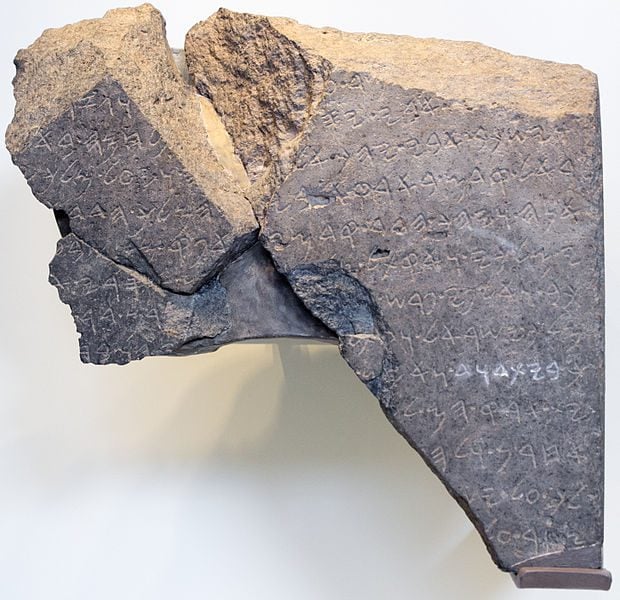
(Wikimedia Commons public domain image)
As I say, we’re headed to Tel Dan (or Tell Dan) in just a few hours. I’m looking forward to it, because I haven’t been to the site in many years (although I’ve passed by the turnoff to it more times than I can count).
A very important discovery was made at Tel Dan during the 1993-1994 excavation season there, close to the entrance of the city’s outer gate. It’s known as the “Tel Dan Stele.”
The Tel Dan Stele is a broken piece of inscribed basalt stone that, altogether, constitutes a portion of a triumphal inscription written in Aramaic. In it, an unidentified king — conjectured to be most likely Hazael of Aram-Damascus, who was an important regional ruler during the late ninth century BC — boasts about his (supposed) victories over mlk ysr’l, the king of the northern Hebrew kingdom, Israel, and his apparent ally, a king of the “House of David” (bytdwd, ביתדוד).
Currently on display in the Israel Museum in Jerusalem, the Tel Dan Stela is significant because it is the earliest widely accepted reference outside of the Bible itself to a person named David as the founder of a Judahite state.
The somewhat earlier Mesha Stele contains several possible references, but they have been debated. A minority of scholars have also disputed the seeming Tel Dan reference to David, and other translations have been proposed. Some scholars — motivated, I personally suspect, as much by ideology as by evidentiary concerns — have even denied its authenticity. (These are what are sometimes called the “biblical minimalists,” who commonly argue that nothing in the biblical account prior to the return from the Babylonian captivity is at all significantly historical.) However, the large majority of academic specialists accept it both as authentic and as referring to the “House of David.”
If authentic, the Tel Dan inscription represents the first time that the name David has been found at an archaeological site that dates to before 500 BC. It is also one of only four known inscriptions created during a roughly four-century period (1200-800 BC) that contain the proper name “Israel,” the others being the Merneptah Stele (which my wife and I recently saw yet again in the Egyptian Museum in Cairo), the Mesha Stele, and the Kurkh Monolith.
Posted from En Gev, Israel












